Even though we’d been underground in the labyrinth just a few short hours, I was already knackered. We had crawled through leaky chatières and a room full of curious cubic stones just to get here but now, sitting in the dim, flickering light of candles and chatting with my new friends I found myself surprisingly relaxed.
The History of the Catas

The guys pop open the wine and bring out some French biscuits – delicately sweet things with a chocolate centre I can’t get enough of. This room is a little like La Plage – lots of colourful graffiti, several large chambers and a rest area consisting of an iron door for a table and large rocks for seats. Tomasz put on some techno music from his phone to kill the background silence and we toasted each other. French wine is good. I usually don’t drink the stuff at all, but I could get used to this.
Around my third cup, I’m starting to feel the effects and hold myself back. We all laugh and Tomasz tells us a story about when he was drunk and lost in the catacombs himself. Another time he and a friend had come across an intoxicated old man on the verge of passing out. He was just sitting there and waiting by the light of his last candle, hoping somebody found and helped him. He was lucky. I start to worry again. The last thing I want is to be disorientated down here with strangers. They’re great guys and all, but we’ve just met and I’m still a little wary they’ll play a trick to try and scare me. Or worse, that we’ll run into some meth-heads.
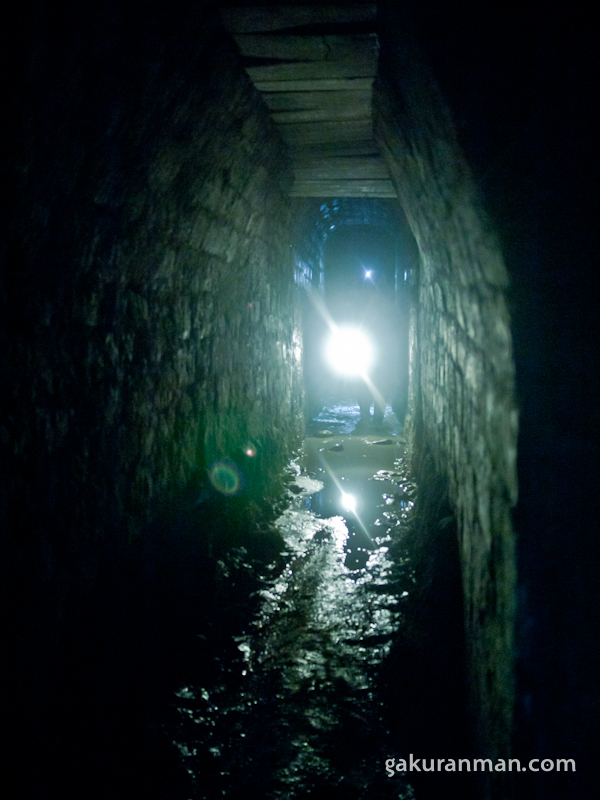
I try to distract myself. Why haven’t we seen any bones so far? You can’t really have catacombs without bones, right?
There are bones of course, but only in select areas of the tunnels. Officially, they are called ‘Les Carrières de Paris’ (the Quarries of Paris) because they were originally excavated for the limestone rock and other building materials beginning as far back as the 1st century during the Roman era. From the 16th century, intensive exploitation of the Paris quarries began. The Quarrymen worked hard in the mines – a tiring occupation with little light. By far one of the most feared conditions was ‘quarryman blindness’, where the workers would lose their sight through years of working in the dark. (Source: Explographies.)
As for the bones, well, that began around the time momentum for the Revolution was mounting in Paris. Cemeteries were becoming unreasonably overcrowded as they became unable to hold all the past residents. In particular, the Les Halles district was suffering from disease caused by poor burials and the ever-rising sea of bodies from mass graves in churchyards. In some places, the ground had risen several feet from the human remains stuffed into them.
The walls in the cellar of a restaurant owner located Rue de la lingerie, (at the actual level of – Les Halles-) ) right next to the Innocents cemetery will break down the 30th of May 1780. The discovery of what will pour into the building’s cellar will cause an unutterable horror: cubic meters of old bones mixed with decomposing cadavers, entangled putrefied mortal remains made the wall give way under their weight. The building is completely contaminated, walls are oozing and it is said that just days after putting his hand on the wall, a mason will catch gangrene. The same happens with the surrounding houses and streets; this cemetery, like all the others in Paris, is a big mass grave located a few meters from apartment buildings, literally placed side-by-side with the cemeteries.
(Source: Explographies)
A decision was made to move the bones underground as discreetly as possible and from 1786 to 1860, millions of bodies were exhumed from Paris cemeteries and placed below into the quarries, transforming several sections into a mass-tomb that are the catacombs as we know them today. One of the biggest necropolis in the world. (Source: PlacesinFrance.)
A Nazi Bunker and Other Stories
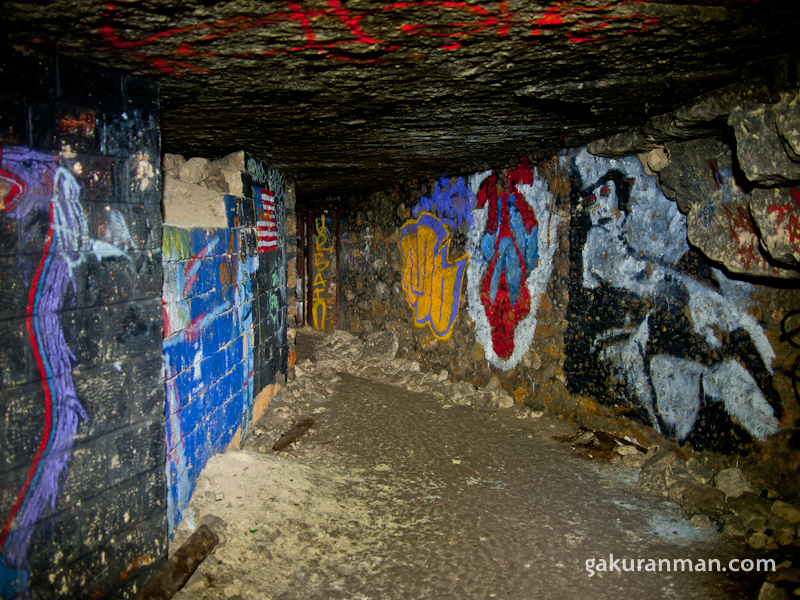
Before going to the Ossuary to see some bones, we had several other places on our visiting list. It was a packed day – 10 hours of time underground and kilometres of walking to do. Explorers have estimated that there are over 300km of tunnel systems in the catacombs. We would only be traversing a small section of them. Even so, it was tiring work. My body already ached from all the ducking and crawling and it wasn’t even lunchtime yet!
Tomasz led the way to an infamous area known as Le Bunker (the Bunker). I looked blankly at the way in – another cat-hole through the wall. Climb through and fall out the other side on your face. It’s all part of the experience, I guess.
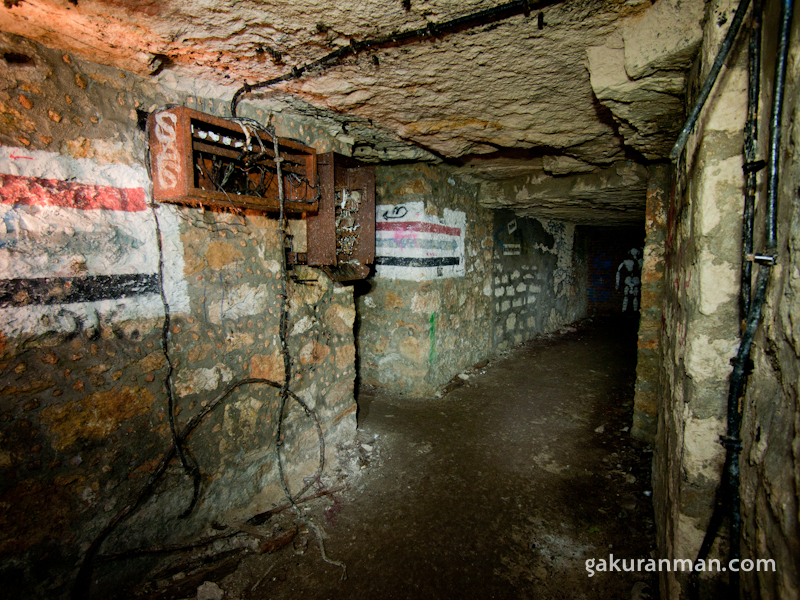
During World War II, the tunnels were used by Parisian members of the French Resistance as a secret headquaters. In addition, they were also used by German soldiers who built this bunker under a high school to strengthen the Nazi hold on Paris.

The walls are different here – brickwork – and there are a few traces of machinery left around. Electrical boxes, an oil drum, benches. What catches my attention though are the signs on the walls. And the numerous arrows pointing in various directions. The words are nearly always the same – ‘Rauchen Verboten’ (No Smoking) and ‘Ruhe’ (Quiet). Good idea. I snap Rafael on his break.
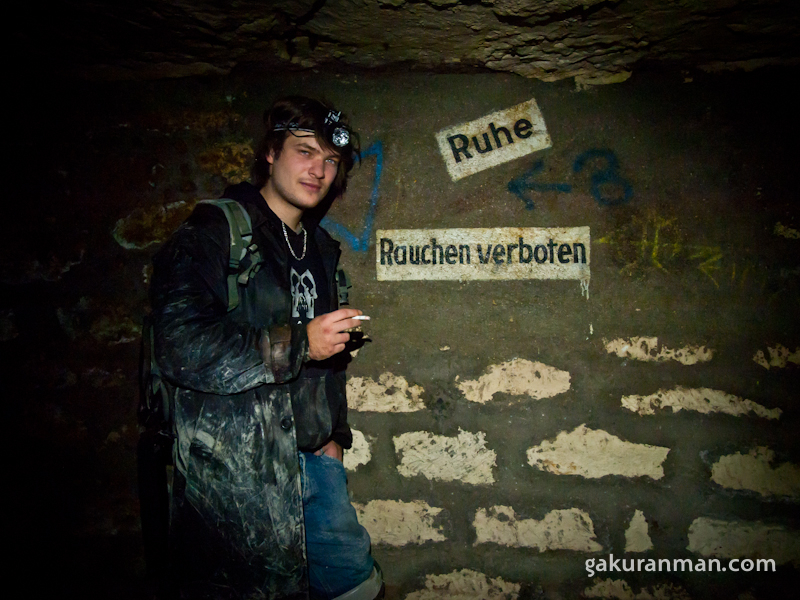
There are many smaller rooms dotted around the Bunker too, often separated by rusty iron gates and great doors with huge round handles – the sort I found on a walk-in safe when visiting one Japanese haikyo. I peer inside hesitantly – nothing but rubble and some rubbish now, but I’d hate to be sealed inside one of these areas. Some lead to storage chambers of sorts – others to further passages. Were these doors to keep wandering people out of the Nazi Bunker or to keep something else in..?

The Bunker alone is big enough to keep an explorer occupied for hours, but we have to press on. Tomasz tells us of a secret chamber just south of it known as La Fontaine des Chartreux (the Fountain of the Chartreux). It’s one of the last vestiges of the monastery of Paris, built after the disappearance of the Order of Carthusian Monks whose numbers dwindled greatly during the French Revolution.
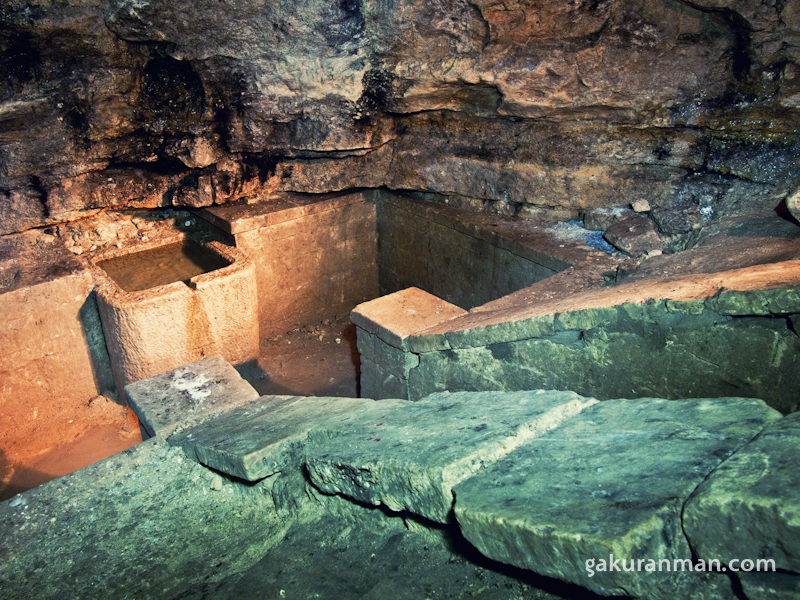
A large double staircase stretches down to the main fountain – a basin collecting water dripping from the surrounding limestone walls. On the left of it is a scale to measure the level of groundwater. But although general opinion might suggest it was a religious place, it was actually constructed in 1819 by the Inspection Générale des Carrières – the General Inspection of the Quarries (IGC for short) in order to supply water to the workers. There had already been collapses in the tunnels and cases of huge chunks of Paris sinking into the ground, so the workers were risking their lives in order to secure the underground passages. (Source: Catacombes.info.)
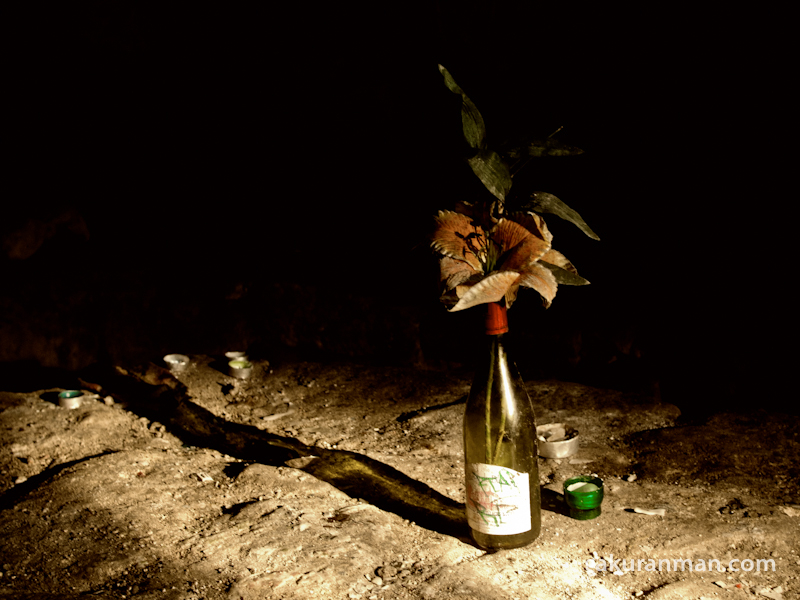
The Legend of Philibert Aspairt
Another place on my list to visit was the grave of Philibert Aspairt. According to myth, Philibert Aspairt was the gatekeeper of the hospital Val de Grâce. One night, he deserted his post and descended into the old quarries in order to steal wine from the monks of the Chartreux. He never returned. It is said that the flickering candle he was carrying went out and he wandered for days before finally succumbing to thirst. His fatal accident was only discovered some ten years later in 1804, his body supposedly just a short distance from an exit. By then though, all that remained was a skeleton and a set of keys that helped identify him. As such, he is usually considered the first of the Cataphiles and his gravestone has become something of a pilgrimage destination. All explorers of these tunnels know this story.
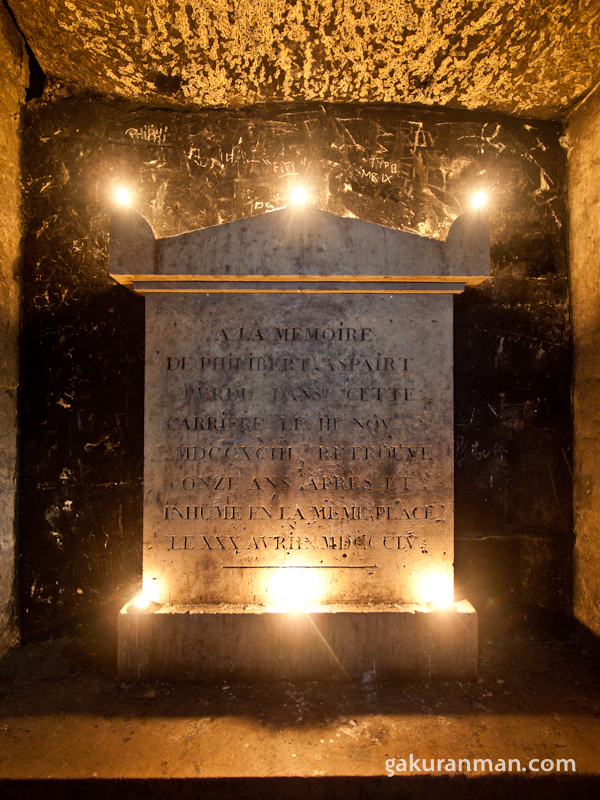
We visit his tomb to pay our respects. The inscription on the stone reads:
In memory of Philibert Aspairt. Lost in this quarry on November 3, 1793, found eleven years later and buried in the same place on April 30, 1804.
There are still some inconsistencies in the story, but a man with a remarkably similar name and circumstances disappearing for 10 or so years – Philibert Asper – seems to match. A copy of his death certificate is below.
(Source: Datacombes)
After taking another short rest, Tomasz scans his map again and we plan to set off. We’re a long way from the next destination – at least 45 minutes in walking – but it’ll all be worth it once we get there. Tomasz begins to tell us a bit about the lower levels of the Catacombs. We’re down perhaps 30 feet at the moment? But allegedly other parts go down well over 100 feet.
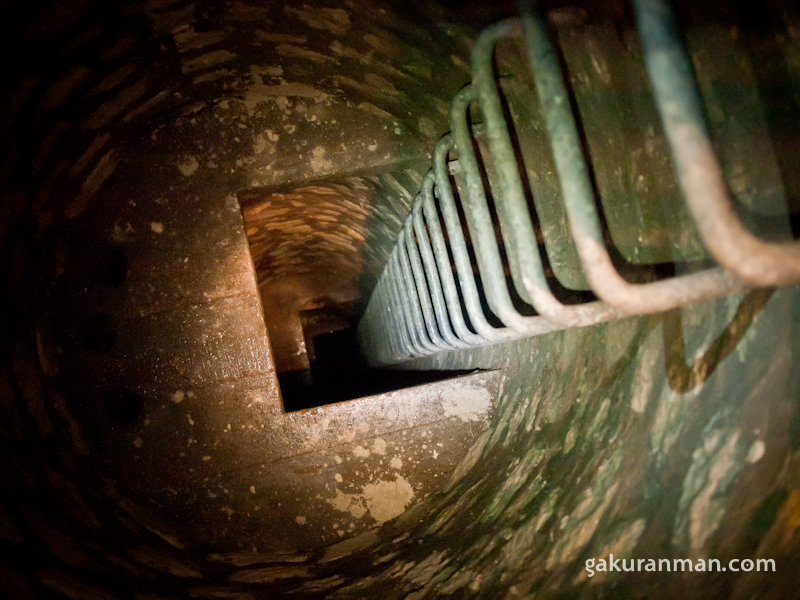
Some people whisper about them even containing the Gateway to Hell. I’m skeptical, but overwhelmed by an intense curiosity. We pass one of the foot ladders stretching down to a lower level but don’t stop; this isn’t the right place and we’ve no time to be splashing around in flooded passages that are largely uncharted. Instead, the final part of our journey awaits at Le Carrefour des Morts – the Crossroads of the Dead. Time to head deeper inside…
**********
Still to come: Mountains of bones at the Crossroads of the Dead, an underground castle, the Skull Altar, man in the wall and the Banga. Be sure to check back for the final part! You can follow me on Twitter and Facebook for updates. Or, you can subscribe to the feed.









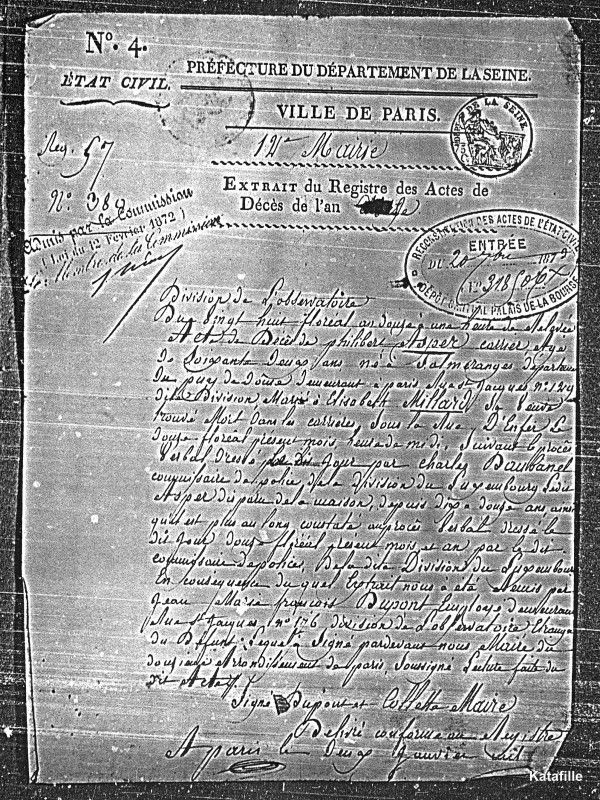
ha ha moi c’est Frog je suis trés interressé par ces histoires de catacombes a la fois sinistre
et underground…. dans les couloirs on s’perd faite gaffe a vous !
Good morning, I am from Czech Republic and I am in Paris now. And I want to see catacombs (not official turist atraction of course) very much. So please can you help me?
As compenzation I can invite you to Czech Republic, where I know amost every place from urbex or other underground.
Thank you very much
I’m going to Paris in a month and was wondering if anyone wanted to come with? Tourists or locals. I’ll go on my own if I can’t find anyone but I’d rather not.
Crap! Total typo! I meant I was wondering if anyone wants to come with to the CATACOMBS, aka the off limits section. Lol
Hello, my name is Hector, and i will be visiting paris in some months. Im looking for a guide to have access to the forbidden parts of the catacombs, can you help me with it?
Interesting reading. I just finished “Catacombs” by Jeremy Bates. Parts of the first section of this was like re-reading the book. Parts were nearly verbatim.
Thanks for the recommendation! I’m curious to read it. Sounds like someone after my own heart :).
That photo of the wine bottle filled with flowers is fantastic. Perfect shot and such great use of what little light you had. I’m headed to Paris late March and Catacombs is on the must-see list. Thanks for sharing!
Thanks and good luck with your exploration. Take care!
Sorry, I just saw the skulls are for the part 3!
Can’t have the Catacombs without the skulls!
Yup yup. Should be up soon! :)
Where are the skulls?
Gakuranman, thanks for doing the things you do and sharing them. Can’t wait for part 3!
Thanks Karl. The ending will be a cracker ;).
Wow!! Another awesome post! Is it all closed to the public now? I thought I remembered reading that certain parts were open to tourists but then noticed your comment about it being restricted since 1955? Upon seeing the warnings in the Nazi bunker all I could think of was this song: http://www.youtube.com/watch?v=i5Ackbtn5bU
There are official catacombs in France that you can pay to visit and photograph. It’s only a very small section of the entire labyrinth that has been made safe for the public though.
Interesting frog sign in that song :p
Great blog post, i’m kinda interested to go and take a look myself.
If anyone is interested, I found an interactive map: http://exploration.urban.free.fr/catacombes/v5-zoom-us.htm
steve
You should! The Nexus maps are by far the best, but even so, you should go with a guide at least the first time. It’s no ordinary urbex and could be dangerous if you get lost. Totally awesome though :)
Great blog man. How do you go about getting a guide? Im off to paris in march and just gotta get down there.
I was lucky enough to have Tomasz contacting me through my website while I was looking. He’s studying in Japan, so he was interested in visiting some Japanese ruins together. I simply asked him about the catacombs and fortunately he and I were due to return home over the winter holidays. If you’re looking for a guide, you might try asking around on the forums related to the Catacombs, or better yet, see if you have any friends with contacts :).
Did you hide the fact that they were smoking pot as they were drinking wine? :p
Haha. Even if they were I couldn’t tell :p
Nice story Gak…..I had no idea such a place would be so unrestricted with even uncharted tunnels able to be explored! Nice. Seems like a place a true adventure could still happen.
That dude was smoking??! in an underground tunnel!
You changed the look and format of your site as well? Why did you get rid of all the color? Why blog style for the front page?
Cheers Jason. Yea, apparently it has been restricted to the public since 1955. I doubt there are many actually ‘uncharted’ tunnels left (somebody is bound to have gone there), but certainly the lower, deeper levels are much harder to access and explore because the water and other problems.
Surprisingly, the smoke didn’t really disperse a lot inside the bunker. There are vents around where manhole covers lead down to the tunnels as well, so eventually the smoke will disappear anyway :).
I changed my site primarily for functionality (the old one was heavy and slow). Doing away with the bioluminescence was a bold move, but I want to see how this one grows on me. It’s certainly a lot lighter (in both design and function). The front page seemed to be too cluttered for me, and because I don’t post that often (except recently), having a slider and separate blog listings didn’t make sense. I’d still like to showcase the best pictures in a slider, but the extra queries on the database would slow down the site more, and I think I can get away without it. We’ll see.